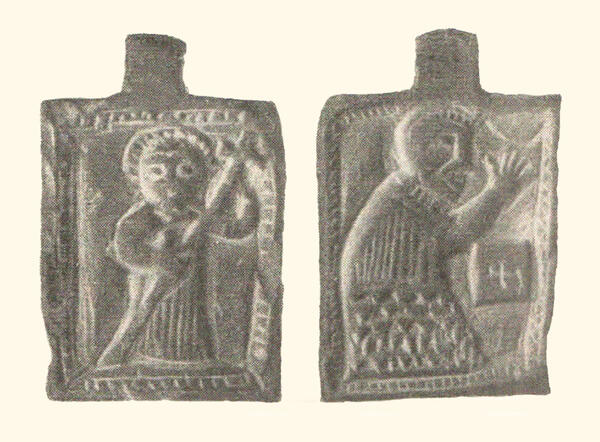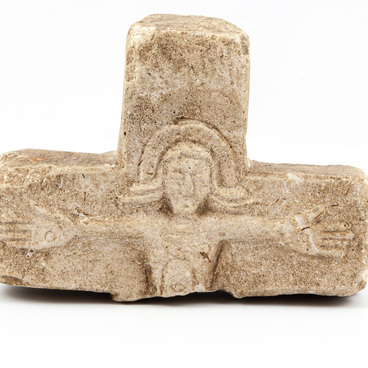Among the finds on the territory of the Holy Trinity Monastery, a stone icon stands out as one of the rarest. It was discovered during the expedition and excavations in 1956. The icon has a rectangular shape. One of its sides depicts a saint with a halo, the other — a kneeling man in profile. The right arm of the figure is stretched out and slightly raised.
Valentin Vasilyevich Sedov, who found this object, distinguished the schematic nature of the image, its special carving technique, and the inaccurate proportions of the body parts. He suggested that the icon had been made by a local craftsman, who must have been familiar with the limestone carvings of the Vladimir-Suzdalian Rus and tried to depict the details of the figures from memory.
Tatyana Vasilyevna Nikolayeva, a researcher of ancient Russian small statuary, dated the icon to the first quarter of the 13th century, and the figures depicted on it were recognized as John the Baptist with a cross and John the Apostle. However, there is another point of view on the subject.
Vasily Grigoryevich Putsko offered his version of the icon’s origin. Judging by numerous similar depictions in Western art, he suggested that one of the figures was in fact an image of Christ, standing with a cross in his hands.
The researcher also expressed his opinion about the second, praying figure. He noted that there was no halo in the image, therefore the depicted person was not a saint. The scientist also noticed that the image showed a hem, decorated with geometric motifs that could be seen under the short clothes. He identified the clothes as an alb — one of the liturgical vestments of a Catholic clergyman.
Vasily Putsko made a conclusion that the carver used a composition that depicted Christ and a clergyman in a pose of prayerful intercession before Christ as an example for his work, but when making the icon, the images were placed on different sides.
Vasily Putsko noted that the item shows a clear influence of Western iconography, which is associated with the Crusader icon painting. The Russian icon carver most likely reproduced a foreign image that could have come to Rus from Palestine or other territories in the early 13th century.
Valentin Vasilyevich Sedov, who found this object, distinguished the schematic nature of the image, its special carving technique, and the inaccurate proportions of the body parts. He suggested that the icon had been made by a local craftsman, who must have been familiar with the limestone carvings of the Vladimir-Suzdalian Rus and tried to depict the details of the figures from memory.
Tatyana Vasilyevna Nikolayeva, a researcher of ancient Russian small statuary, dated the icon to the first quarter of the 13th century, and the figures depicted on it were recognized as John the Baptist with a cross and John the Apostle. However, there is another point of view on the subject.
Vasily Grigoryevich Putsko offered his version of the icon’s origin. Judging by numerous similar depictions in Western art, he suggested that one of the figures was in fact an image of Christ, standing with a cross in his hands.
The researcher also expressed his opinion about the second, praying figure. He noted that there was no halo in the image, therefore the depicted person was not a saint. The scientist also noticed that the image showed a hem, decorated with geometric motifs that could be seen under the short clothes. He identified the clothes as an alb — one of the liturgical vestments of a Catholic clergyman.
Vasily Putsko made a conclusion that the carver used a composition that depicted Christ and a clergyman in a pose of prayerful intercession before Christ as an example for his work, but when making the icon, the images were placed on different sides.
Vasily Putsko noted that the item shows a clear influence of Western iconography, which is associated with the Crusader icon painting. The Russian icon carver most likely reproduced a foreign image that could have come to Rus from Palestine or other territories in the early 13th century.



